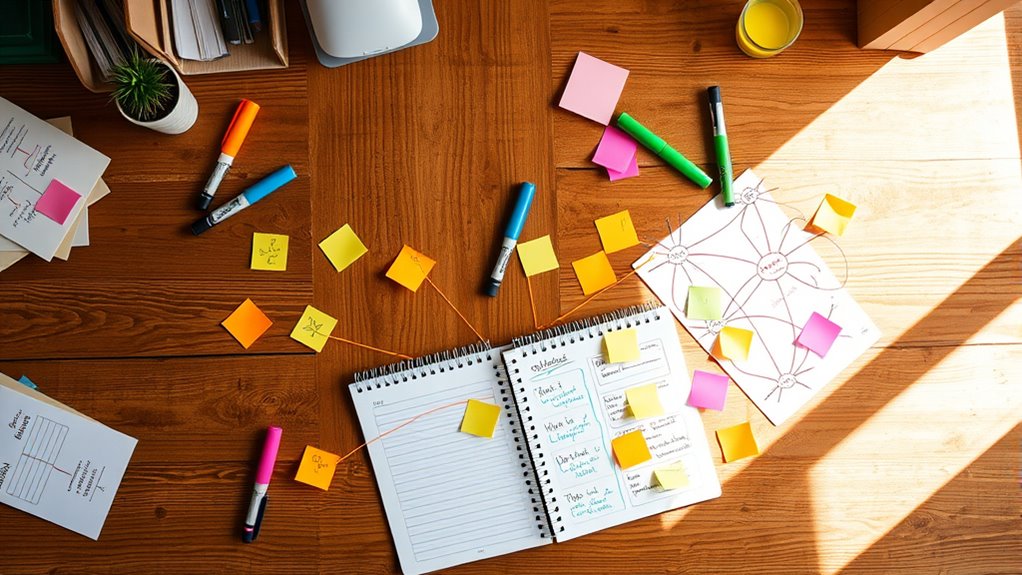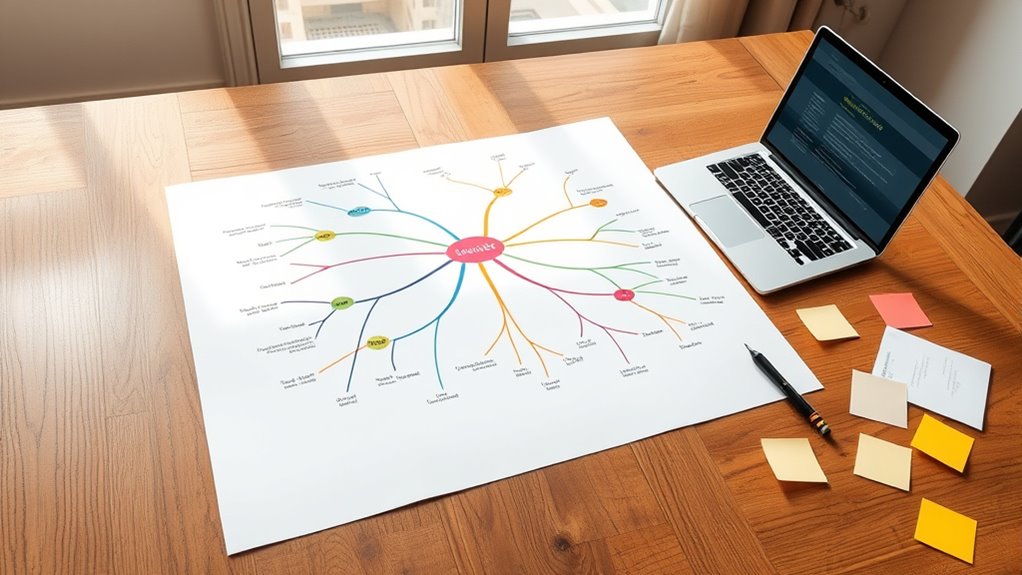Using mind maps to organize your notes helps you visualize information, making it easier to understand and recall. You can create a central idea with branches for related topics, using colors and images to highlight key points. This approach fosters creativity and active engagement, aiding in memory retention and pattern recognition. If you want to discover how to make your notes more effective and engaging, there’s more to explore ahead.
Key Takeaways
- Start with a central idea and branch out related topics to create a clear visual hierarchy.
- Use colors, images, and symbols to differentiate main concepts and subtopics for better recall.
- Organize notes organically by adding branches as new ideas or details emerge during discussions or study.
- Highlight key ideas and supporting details to facilitate quick review and reinforce memory retention.
- Incorporate creative elements to engage actively with the material, improving understanding and long-term retention.

Have you ever struggled to organize your notes in a way that makes sense? If so, you’re not alone. Many people find traditional note-taking methods cluttered and hard to navigate. That’s where mind maps come in. They’re a powerful tool for visually organizing information, making it easier to understand and recall. When you create a mind map, you’re fundamentally building a visual hierarchy of ideas. This structure lets you see how concepts connect and prioritize what’s most important, which is especially useful during creative brainstorming sessions. Instead of endless bullet points, you lay out your thoughts in a radial diagram, with a central idea at the core and related ideas branching out. This format helps your brain process information more holistically, enabling you to spot relationships and patterns more easily. Using a mind map encourages you to think more creatively about how you organize your notes. As you start, don’t just jot down facts—consider how ideas relate to each other. This process sparks your creativity, pushing you to explore different angles and connections you might not have thought of with linear notes. You can use colors, images, and symbols to emphasize certain branches or ideas, which further enhances your visual hierarchy. This visual layering makes it simple to distinguish main concepts from subtopics, giving your notes a clear structure. When your notes have a strong visual hierarchy, reviewing them becomes faster because you immediately see which ideas are central and which are supporting details. Incorporating auditory cues such as sound or music can further reinforce memory retention and engagement with your notes. Creating a mind map also facilitates creative brainstorming. As you draw out ideas, you’re not just recording information—you’re actively engaging with it. This active participation boosts your memory and understanding. You can easily add new ideas in real-time during discussions or solo work, capturing fleeting thoughts that might otherwise be lost. The open-ended nature of mind maps encourages free thinking; you’re not confined to a linear order, so your mind can wander and explore new paths. This flexibility makes mind maps an excellent tool for problem-solving and planning projects. Plus, since they’re visual, they’re more engaging than traditional notes, motivating you to continue exploring and expanding your thoughts. In core, adopting mind maps transforms how you organize your notes. They help you establish a clear visual hierarchy, making information more accessible. They also promote creative brainstorming by allowing your ideas to grow organically. Whether you’re studying, working on a project, or preparing for a presentation, mind maps give you a dynamic way to see the bigger picture while keeping details manageable. So, give them a try—your notes will become more meaningful, and your thinking more creative.
Frequently Asked Questions
Can Mind Maps Improve Memory Retention?
You might wonder if mind maps can boost your memory retention. The answer is yes, because they leverage your visual memory and provide cognitive benefits. By organizing information visually, you engage different parts of your brain, making it easier to recall details later. Mind maps help you see connections clearly, strengthen your understanding, and improve long-term retention, making study sessions more effective and less stressful.
What Tools Are Best for Creating Digital Mind Maps?
Think of digital mind map tools as your creative paintbrushes. For the best results, choose ones that offer visual customization so you can personalize your ideas vividly. Cloud synchronization is essential, letting you access your maps anytime, anywhere. Top tools like MindMeister, XMind, and Coggle shine because they combine intuitive design with these features, helping you organize thoughts seamlessly and bring your ideas to life with clarity and color.
How Do I Start When I Have Complex Information?
When tackling complex information, start by breaking it into main ideas and subtopics. Use visual hierarchy to prioritize key points and organize related details clearly. Incorporate color coding to distinguish categories and make connections easier to see. Begin with a central theme and branch out gradually, adding details as you go. This approach helps you stay focused, understand relationships, and create a clear, manageable overview of even the most complicated information.
Are Mind Maps Suitable for Collaborative Note-Taking?
You wonder if mind maps are suitable for collaborative note-taking. They’re great for brainstorming benefits, as they visually organize ideas and encourage input from everyone. Using collaborative strategies like shared digital mind maps allows team members to add, edit, and connect ideas seamlessly. This promotes active participation, clarifies complex concepts, and fosters creativity. Overall, mind maps make teamwork more efficient and engaging, especially when capturing diverse perspectives in real-time.
How Often Should I Update My Mind Maps?
You should update your mind maps regularly to maintain a clear visual hierarchy and keep information current. As you learn new details or ideas emerge, adjust your color coding and structure to reflect these changes. Frequent updates guarantee your notes stay organized, making it easier to review and understand. Aim for weekly or after significant study sessions, so your mind map remains a dynamic tool that adapts with your knowledge growth.
Conclusion
Now that you know how to use mind maps to organize your notes, you’ll find studying becomes more intuitive and less overwhelming. By visually connecting ideas, you can see the bigger picture and remember details more easily. So, why not give it a try and turn your scattered notes into a clear, creative map? Once you do, you’ll wonder how you ever studied without it. Start mapping your way to better understanding today!









